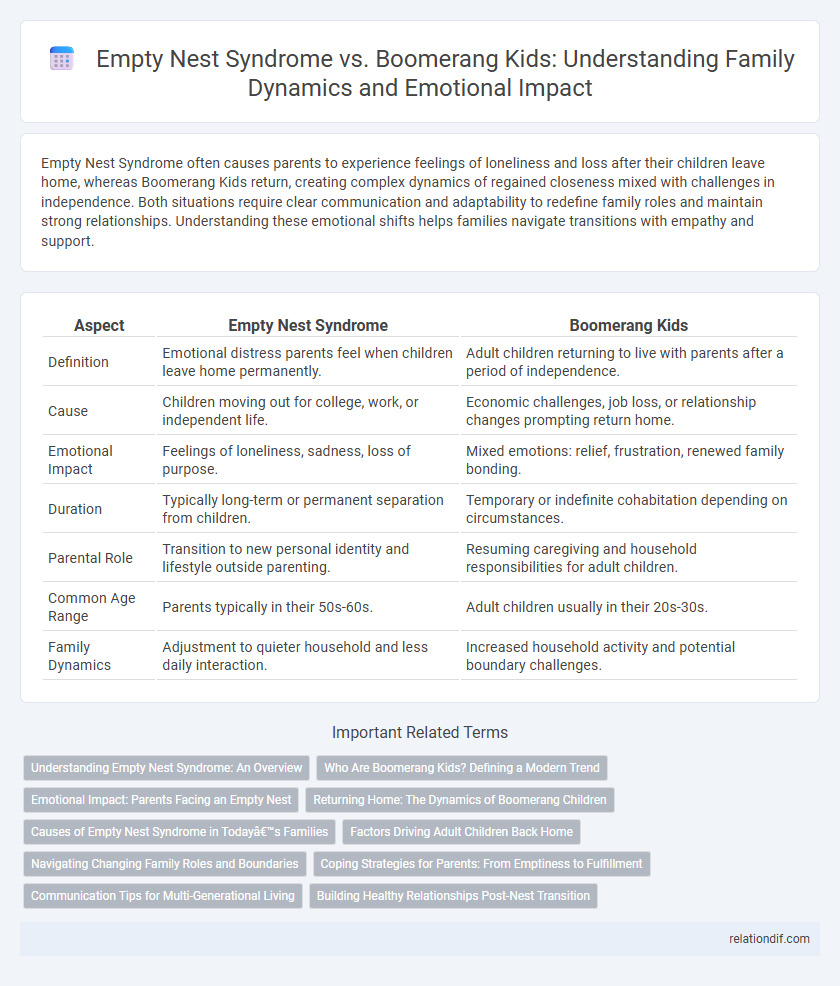Empty Nest Syndrome often causes parents to experience feelings of loneliness and loss after their children leave home, whereas Boomerang Kids return, creating complex dynamics of regained closeness mixed with challenges in independence. Both situations require clear communication and adaptability to redefine family roles and maintain strong relationships. Understanding these emotional shifts helps families navigate transitions with empathy and support.
Table of Comparison
| Aspect | Empty Nest Syndrome | Boomerang Kids |
|---|---|---|
| Definition | Emotional distress parents feel when children leave home permanently. | Adult children returning to live with parents after a period of independence. |
| Cause | Children moving out for college, work, or independent life. | Economic challenges, job loss, or relationship changes prompting return home. |
| Emotional Impact | Feelings of loneliness, sadness, loss of purpose. | Mixed emotions: relief, frustration, renewed family bonding. |
| Duration | Typically long-term or permanent separation from children. | Temporary or indefinite cohabitation depending on circumstances. |
| Parental Role | Transition to new personal identity and lifestyle outside parenting. | Resuming caregiving and household responsibilities for adult children. |
| Common Age Range | Parents typically in their 50s-60s. | Adult children usually in their 20s-30s. |
| Family Dynamics | Adjustment to quieter household and less daily interaction. | Increased household activity and potential boundary challenges. |
Understanding Empty Nest Syndrome: An Overview
Empty Nest Syndrome occurs when parents experience feelings of loss or sadness after their children leave home, often leading to emotional challenges and identity shifts. This emotional state contrasts with the Boomerang Kids phenomenon, where adult children return to live with their parents due to economic or personal reasons. Understanding Empty Nest Syndrome involves recognizing the psychological impact on parental roles and the transition to a new family dynamic.
Who Are Boomerang Kids? Defining a Modern Trend
Boomerang kids are adult children who return to live with their parents after a period of independence, often due to economic challenges or personal transitions. This modern trend contrasts with Empty Nest Syndrome, where parents experience emotional distress after their children leave home permanently. Boomerang living has become increasingly common in urban areas with high living costs, reflecting shifting family dynamics and financial realities.
Emotional Impact: Parents Facing an Empty Nest
Parents experiencing Empty Nest Syndrome often face feelings of loneliness, sadness, and loss as their children leave home for college or career opportunities. In contrast, boomerang kids returning home can create mixed emotions, including relief and anxiety, as parents adjust to renewed responsibilities and altered household dynamics. Emotional adjustments in both scenarios significantly affect parental well-being and family relationships during transitional life stages.
Returning Home: The Dynamics of Boomerang Children
Boomerang children, typically young adults aged 18 to 34, return to their parental homes due to factors like economic challenges, job instability, or pursuing further education, impacting family dynamics significantly. This return can lead to role adjustments for both parents and children, often requiring renegotiation of boundaries, responsibilities, and privacy within the household. The phenomenon contrasts with Empty Nest Syndrome, where parents experience emotional adjustment after children leave home, highlighting different psychological and practical implications of family transitions.
Causes of Empty Nest Syndrome in Today’s Families
Parents often experience Empty Nest Syndrome due to significant lifestyle changes, emotional adjustment, and diminished daily interactions when children leave for college or start independent living. Modern factors such as delayed child independence, increased parental involvement, and shifting family roles amplify feelings of loneliness and identity loss. Societal expectations and digital connectivity can also heighten the sense of emptiness by contrasting parents' reduced family engagement with their children's active social lives.
Factors Driving Adult Children Back Home
Financial challenges, prolonged education, and job market instability contribute significantly to adult children returning home, intensifying the dynamics of Boomerang Kids. Emotional support needs and caregiving responsibilities also drive this trend, contrasting with Empty Nest Syndrome where parents adjust to an absent household. Cultural shifts toward multi-generational living further influence the increasing prevalence of Boomerang Kids in modern families.
Navigating Changing Family Roles and Boundaries
Empty Nest Syndrome often triggers emotional adjustments as parents confront the absence of daily caregiving, requiring redefinition of identity and household dynamics. Boomerang Kids re-entering the family home challenge boundaries and necessitate clear communication to balance independence with support, reshaping roles between adult children and parents. Navigating these transitions involves establishing mutual expectations and fostering resilience to maintain healthy family relationships amid evolving responsibilities.
Coping Strategies for Parents: From Emptiness to Fulfillment
Parents navigating Empty Nest Syndrome can benefit from establishing new routines, pursuing personal hobbies, and strengthening social connections to transform feelings of emptiness into fulfillment. Embracing open communication and setting clear boundaries helps families adapt when boomerang kids return home, fostering mutual respect and independence. Utilizing support groups and professional counseling enhances emotional resilience, enabling parents to cope effectively with transitions in family dynamics.
Communication Tips for Multi-Generational Living
Effective communication strategies enhance relationships in multi-generational homes coping with Empty Nest Syndrome or Boomerang Kids dynamics. Establishing clear boundaries and regular family meetings fosters understanding and respect among parents and adult children. Utilizing active listening and expressing empathy reduces conflicts and supports emotional adjustment during role transitions within the household.
Building Healthy Relationships Post-Nest Transition
Empty Nest Syndrome can challenge parents emotionally as children leave home, requiring deliberate communication and empathy to adapt to the new family dynamic. Boomerang kids returning home necessitate setting healthy boundaries and fostering mutual respect to maintain independence while supporting reintegration. Prioritizing open dialogue and understanding each family member's needs helps build resilient relationships after the nest transition.
Empty Nest Syndrome vs Boomerang Kids Infographic

 relationdif.com
relationdif.com